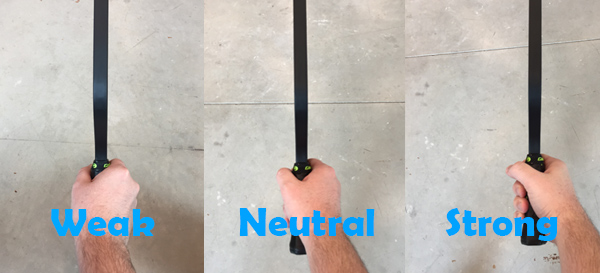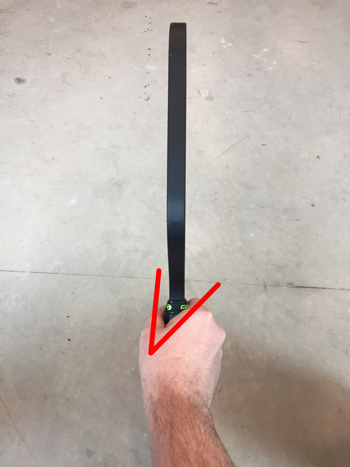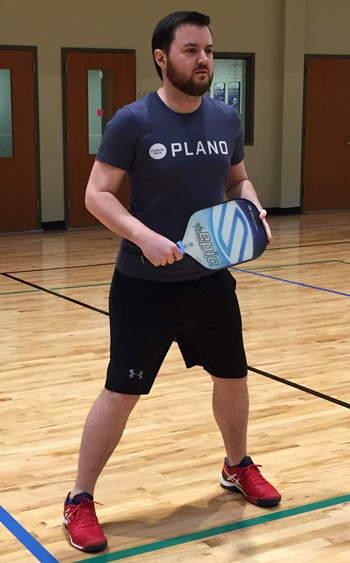It seems simple, doesn’t it? How hard can it be to hold a pickleball paddle? Well, it’s not about how hard it is to hold the paddle. It’s about how holding a pickleball paddle correctly can give you a much better start in pickleball. It’s important to get these fundamentals of pickleball right from the start because bad habits will be much harder to fix later down the road.
So let’s get a good start! In this article, I’m going to teach you how to hold a pickleball paddle correctly, but also where to hold it. I’ll also show you how to hold the paddle during certain situations.
Before we begin, grab a paddle and a ball. As I’m talking about the different ways to hold your paddle, try them out yourself and see what you think. Also, if you’re a lefty, just flip everything around and it will work just the same. Enough chit-chat, let’s do this!
The grip itself
Holding a pickleball paddle is easy. You just pick it up and grab the handle. But holding a pickleball paddle correctly is a bit different than just simply grabbing it.
The standard grip
There are a few different types of grips out there, but we’re just going to focus on the most standard one. There’s no need to use any other type of grip than this one. This grip is what the majority of players use and is what comes naturally to most people.
The grip we’ll be focusing on is called the continental grip.
I’ve got good news for you. You’re most likely already using this grip! It’s very simple.
Shake hands and makeup
The easiest way to understand the way this grip works is to pretend like you’re shaking hands with the paddle. I got this tip from my friend Dom. Check out this image:

This is how you grip the paddle:
- Reach out with your palm towards the handle as if you’re about to shake hands with someone.
- Wrap your hands around the paddle.
- Make sure that the “V” that you create with your thumb and index finger is pointing towards you.

I took this picture right after I took the two above. This is the same grip, just from above. Do you see how my thumb and index finger create a “V” that points at me? This is what you want. This is what the continental grip looks like.
But this isn’t the only way that you can use this grip. There are certain “variants” to this grip that are very useful.
Strong, weak, and neutral
I’ve shown you how to hold a pickleball paddle using the continental grip, but are there other ways to use this grip? There sure are! I’ve got some variations to show you that will help you to achieve different results.
In pickleball, there are strong, weak and neutral grips. These are all important to understand to use the continental grip to its fullest extent.
Earlier in the article, we talked about how to hold the continental grip. I showed you how the “V” should point towards you. This is a neutral grip. Think of the “V” as an arrow that tells you what position you’re in. Look at this series of pictures:

These are the three variations of the continental grip. On the left, the “V” is pointing towards the left, which means it’s a weak grip. In the middle, we have the neutral grip. And on the right, the “V” is pointing towards the right, so that indicates a strong grip. There are uses for these variations, as I’ll explain in a bit.
Before I get into each grip, I need to explain something important. You’re probably thinking to yourself, “Wait, do I have to switch my grip all the time while I’m playing?” The answer is yes, but I have good news for you.
Switching your grip during a point will become ingrained in your muscle memory and thus will become an unconscious action. There will be no need to consciously say to yourself, “Ok, I need to adjust my grip before this shot.” In fact, I bet you’re already doing this before I explained it.
The neutral grip
This is the bread and butter continental grip. Most of the time, you’ll be using this grip unless you prefer something else.
This neural position will allow you to perform the vast majority of shots in pickleball, but it’s especially useful for forehand and backhand dinks and drives. This is especially true for dinks.
The strong grip
It’s time to have some fun.
The strong grip is exactly what it sounds like. This grip is primarily used for aggressive shots when the opportunity arises, but it’s especially useful for the overhead smash. There’s a biomechanical reason for this that I’ll explain in a bit. Here’s what a strong grip looks like:

Notice how the V is now pointing towards my right. This is what the strong grip looks like. Don’t be surprised if your grip has a tendency to do this all the time, even when you think you’re in neutral.
To use this grip:
- Start with your hand in the neutral grip position.
- Simply rotate the grip to the right (to the left if you’re left-handed).
- Adjust the grip so that it’s comfortable.
There you have it! The strong continental grip. It’s time to smash some balls!
What it’s used for
You’ll primarily use this grip for overhead smashes or aggressive forehand shots. Keep in mind though, this grip isn’t great for underhand strokes or in other words, dinking. If you’re at the net, it’s best to use a neutral grip.
So why do you get so much power from a strong grip? Because your paddle, your wrist, and your arm are all aligned. This gives you more wrist action, which in turn, gives you more power.
Try it out yourself. If you’re using a weak, or even a neutral grip, you’ll notice that you can’t perform the overhead smash as well. But when you use a strong grip, you can let it rip.
A word on weak grips

A weak grip, (where you rotate your hand to the left), doesn’t see much use in pickleball. Unless you can find a use for it with your game, I wouldn’t bother with it. A weak grip makes overhead smashes impossible with your forehand. The only benefit that I’ve noticed while using a weak grip is that it makes it easier to get that paddle face open. If you’re keen on using spin shots and cuts, then this may be a good grip for you, but it’s unlikely. I would stick with the neutral and strong grips.
Where to hold the paddle
Now that we know how to hold the paddle, where do we hold it exactly? Should the paddle be down at our side? In front of our face? Should we hold it in front of us perpendicular to our shoulder line?
Again, let’s keep it simple.

You probably recognize this picture from the sidebar to the right of this article. I originally took this picture so that I could just show people that I’m an actual real person. I didn’t realize that it would make such a great image for showing what the neutral ready position looks like.
A position like this isn’t 100% requried in pickelball. If you like to hold your paddle out in front of you like they do in tennis, then go for it. Do whatever is best for you, but make sure that it works!
Neutral position
The image above is where the paddle should be positioned to provide the most benefits and to be ready for most situations that pickleball can throw at you. As you can see, I’m in a comfortable position with a slightly strong grip. That’s typically what I prefer. I also have my hand on the other end of the paddle. This makes me feel more balanced, and it helps me to keep the paddle still and light feeling. It’s what works best for me.
At the net
You should have the same position at the net, but there’s something different at play here. When you’re in a neutral position at the baseline, you don’t have to worry much about overhead smashes. But when you’re at the net, this is a different story. You must be prepared for them.
I have an entire article written about blocking power shots, but in general, you want to bend your knees and get that paddle out in front of you. Don’t back off and don’t turn around when it’s coming at you. I know it can be scary, but if you practice enough, you can start blocking them eventually.
Got a grip on it?
I hope all of that made sense to you. Learning how to hold your paddle effectively is one of the first steps to learning the game. If it feels awkward to you, try not to worry about it. Over time, you will get used to it. Do you use any other type of grip? I would love to hear about it so write me a note below!



Comments 23
Are there different length grips available? What is standard? I have big hands and feel I need a longer grip. Thanks
Does some part of your hand have to be touching the paddle handle when striking the ball? Can you hold the paddle on the face of the paddle while striking the ball?
I am a small tennis player. I have found that holding the pickleball racquet with the end in the palm of your hand to be an advantage. I have a little more reach and more power. Comparing to tennis racquet this is still light and easy to control.(9 oz vs 12 oz) The extra swing weight will allow you to slow your swing and that will also minimize your errors. This grip is not for everyone since bigger players do not need the extra length and power and my find this grip more difficult to control since your hand will be farther away from the ball.
Author
That’s exactly what I do as well.
I’m curious about why a lot of pickleball grips or handles aren’t more like tennis racket grips. Specifically, I mean why aren’t the 8 bevels more defined? Especially, 2,4, 6, and 8. Many tennis players are taught to index the paddles for a continental grip by placing the first knuckle of one’s index finger on bevel 2. I’m asking because my newest paddle has a barely defined #2 bevel and I’m finding it difficult to get used to. I’ve also checked many of my friend’s paddles and these same bevels are similarly Ill-defined.
Also, can anything be done to modify the grip or handle and make these bevels more defined?
Author
One thing you can do to make them more defined is to take the “factory” grip off. A lot of the grips that come with paddles have a lot of padding and ribs on them. Then, apply a thin overgrip directly onto the wood or plastic that the handle is made of. That should help to make the grip more defined. Pickleball doesn’t do 1, 2, 3 etc. bevels. We just do a simple continental grip and that’s it.
I have Rheumatoid arthritis and my index finger is very stiff where it will not bend around the paddle for a continental grip. I place my index finger behind the paddle head. Any suggestions for this problem? Keep doing what I am doing or another idea. Thanks,
I am also curious about keeping my pointer finger on the back of the paddle rather than wrapped around the handle. Is this detrimental in any way? I’ve had the ball hit my finger but I only recall one instance. Thanks
Barrett,
I have a question about grip. I use a “continental” grip, but I find myself attempting to change the grip between forehand and backhand like I do in tennis. I have found out that there is no time in quick exchanges in Pickleball to do that……feels a little “uncomfortable” to use the same grip for both….forehand feels OK….but backhand is more difficult. There is time when you are on the baseline….I was wondering how the Pros and good players deal with this….I don’t ever hear it talked about….anyway, like to get your thoughts on this subject.
Author
For pickleball, the continental grip is the best option for you to go for. Some people will change their grip, but only for shots that they have time for. The overhead smash is an example that comes to mind. I change my grip on that one. The tennis skills that you’ve learned before are valuable, however, I would try to keep the grip-changing down to a minimum. I know it feels weird, but the more you get used to that, the better it will be in the long run. Thanks for stoping by!
Hi Barrett. Long time tennis player. I start pickle ball tomorrow due to age limits. I may be wrong, but in tennis, what you call the continental grip is the eastern forehand grip. Great for forehands, but not backhands. It puts a strain on the forearm muscles. What you call the “weak grip,” is called the continental grip which all the pros use for most every shot but forehands. I have a good backhand because i prepare for it by rotating racket left to your weak grip. Your strong grip is called the western grip in tennis. It’s widely used for strong topspin forehands. I’ll know more tomorrow if this applies to pickle ball.
Author
Ah yes, I’ve been meaning to change this. Thanks for letting me know.
That’s awesome that you’re starting pickleball! Have fun out there and definitely let me know how it goes!
Is it within the rules to use a lanyard (cord) attached to the paddle that wraps around the wrist? Like racquetball paddles are equipped with. (for safety)
I’m new to pickle ball but a long time racquetball player. (I like using a lanyard)
I’m using a Gearbox paddle that is set up to use a lanyard. (at the butt cap of the paddle)
I have yet to see anyone using a lanyard on their paddle.
Also, is it ok to use a glove like everyone does in racquetball?
Thanks. I’m learning a lot from your YouTube channel by the way.
Author
That should legal. I don’t see any reason why it wouldn’t be and I’ve never read anything about that being illegal. Glad you’re getting a lot out of the videos! Thanks for stopping by!
How do you know if the grip on your paddle is large enough?
Author
Hmmm, that’s a good question. I’ve been sitting here thinking about some potential answers, but most of them are personal and subjective. What I would do is try a different paddle that has a smaller or larger handle and just see how that feels. Keep comparing them back and forth and then look up the paddle to find the grip circumference. Also remember that you can apply overgrip tape to make it even thicker.
Just curious, what grip do the majority of the professionals use? It appears a lot of them come from a tennis background where changing grips from forehand to backhand is commonplace.
Author
I’m not 100% sure about this, but most are probably using the continental grip.
Should the grip be in the palm or in the fingers like a golf club? I found it easier to hit shots into the kitchen clearing the net with the palm grip. If you look at the paddle it kinda flattens out the paddle to get under the ball better.
Author
It’s half and half. The handle should be in your palm, but it doesn’t have to completely surround it. Do whatever is comfortable for you.
just found your podcast, nice job
Thanks Barrett.
Any news on the YouTube channel and a new podcast?
Author
New podcast is out Monday morning. YouTube is coming……….. soon!